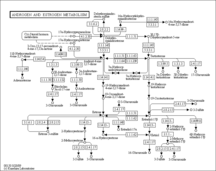Showing metabocard for 19-Hydroxytestosterone (HMDB0006769)
Only showing the first 10 proteins. There are 24 proteins in total.
Enzymes
- General function:
- Involved in monooxygenase activity
- Specific function:
- Cytochromes P450 are a group of heme-thiolate monooxygenases. In liver microsomes, this enzyme is involved in an NADPH-dependent electron transport pathway. It performs a variety of oxidation reactions (e.g. caffeine 8-oxidation, omeprazole sulphoxidation, midazolam 1'-hydroxylation and midazolam 4-hydroxylation) of structurally unrelated compounds, including steroids, fatty acids, and xenobiotics. Acts as a 1,8-cineole 2-exo-monooxygenase. The enzyme also hydroxylates etoposide.
- Gene Name:
- CYP3A4
- Uniprot ID:
- P08684
- Molecular weight:
- 57255.585
- General function:
- Involved in monooxygenase activity
- Specific function:
- Cytochromes P450 are a group of heme-thiolate monooxygenases. In liver microsomes, this enzyme is involved in an NADPH-dependent electron transport pathway. It oxidizes a variety of structurally unrelated compounds, including steroids, fatty acids, and xenobiotics. This enzyme contributes to the wide pharmacokinetics variability of the metabolism of drugs such as S-warfarin, diclofenac, phenytoin, tolbutamide and losartan.
- Gene Name:
- CYP2C9
- Uniprot ID:
- P11712
- Molecular weight:
- 55627.365
- General function:
- Involved in monooxygenase activity
- Specific function:
- Responsible for the metabolism of a number of therapeutic agents such as the anticonvulsant drug S-mephenytoin, omeprazole, proguanil, certain barbiturates, diazepam, propranolol, citalopram and imipramine.
- Gene Name:
- CYP2C19
- Uniprot ID:
- P33261
- Molecular weight:
- 55944.565
- General function:
- Involved in monooxygenase activity
- Specific function:
- Metabolizes several precarcinogens, drugs, and solvents to reactive metabolites. Inactivates a number of drugs and xenobiotics and also bioactivates many xenobiotic substrates to their hepatotoxic or carcinogenic forms.
- Gene Name:
- CYP2E1
- Uniprot ID:
- P05181
- Molecular weight:
- 56848.42
- General function:
- Involved in monooxygenase activity
- Specific function:
- Exhibits low testosterone 6-beta-hydroxylase activity.
- Gene Name:
- CYP3A43
- Uniprot ID:
- Q9HB55
- Molecular weight:
- 57756.285
- General function:
- Involved in monooxygenase activity
- Specific function:
- Cytochromes P450 are a group of heme-thiolate monooxygenases. In liver microsomes, this enzyme is involved in an NADPH-dependent electron transport pathway. It oxidizes a variety of structurally unrelated compounds, including steroids, fatty acids, and xenobiotics. Participates in the metabolism of an as-yet-unknown biologically active molecule that is a participant in eye development.
- Gene Name:
- CYP1B1
- Uniprot ID:
- Q16678
- Molecular weight:
- 60845.33
- General function:
- Involved in monooxygenase activity
- Specific function:
- Cytochromes P450 are a group of heme-thiolate monooxygenases. In liver microsomes, this enzyme is involved in an NADPH-dependent electron transport pathway. It oxidizes a variety of structurally unrelated compounds, including steroids, fatty acids, and xenobiotics.
- Gene Name:
- CYP2C18
- Uniprot ID:
- P33260
- Molecular weight:
- 55710.075
- General function:
- Secondary metabolites biosynthesis, transport and catabolism
- Specific function:
- May be involved in the metabolism of various pneumotoxicants including naphthalene. Is able to dealkylate ethoxycoumarin, propoxycoumarin, and pentoxyresorufin but possesses no activity toward ethoxyresorufin and only trace dearylation activity toward benzyloxyresorufin. Bioactivates 3-methylindole (3MI) by dehydrogenation to the putative electrophile 3-methylene-indolenine.
- Gene Name:
- CYP2F1
- Uniprot ID:
- P24903
- Molecular weight:
- 55500.64
- General function:
- Involved in monooxygenase activity
- Specific function:
- Not Available
- Gene Name:
- CYP4X1
- Uniprot ID:
- Q8N118
- Molecular weight:
- 58874.62
- General function:
- Involved in monooxygenase activity
- Specific function:
- Cytochromes P450 are a group of heme-thiolate monooxygenases. In liver microsomes, this enzyme is involved in an NADPH-dependent electron transport pathway. It oxidizes a variety of structurally unrelated compounds, including steroids, fatty acids, and xenobiotics. Acts as a 1,4-cineole 2-exo-monooxygenase.
- Gene Name:
- CYP2B6
- Uniprot ID:
- P20813
- Molecular weight:
- 56277.81
Only showing the first 10 proteins. There are 24 proteins in total.
